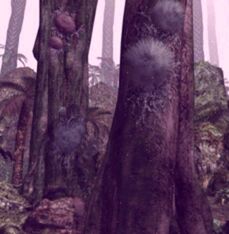Neglabana is a dangerous, but edible fungal species from Eingana.
Neglabana is a mold analogue, growing in the tropical and, rarely, the subtropical regions of the planet. It is particularly common on the bark of certain tree-like ferns and some thick, woody vines, favouring akkango vines in particular. In fact, its preference is dependent not on the plant species, but on the particular combination of conditions the aforementioned plants tend to prefer. Neglabana favors humid places, but moderately so, avoiding marshlands. The fungus grows in large round spots, often more than two meters in diameter and up to 30cm. thick in the middle of the hyphae concentrations.

Moderately-sized neglabana growths on tree bark. Note the visually perceptible air contamination.
When growing in deep, narrow ravines and natural rifts, neglabana concentrations can pose lethal toxic hazard, saturating the air with a mixture of noxious gases, byproduct of the fungi's growth. Any animal lifeforms that perish due to exposure to such gases serve as a fertilizer for the soil and local vegetation on which neglabana grows. The fungus itself does not spread on decaying animal-based biological matter, repelled by its toxins.
The spores, however, are mostly harmless, non-toxic and surprisingly hypo-allergic for all but the most sensitive people. Neglabana doesn't accumulate eezo and heavy metals from the planet's heavily tainted soil and plant life, but doesn't reject and expel eezo from its biomass, unlike chemical contaminants.
The biomass of neglabana, while visually unappealing, is edible and can be remarkably flavourful, when cooked properly, usually by boiling in lightly salted water. It is free from toxins and, unlike many other fungi, does not absorb harmful chemicals, heavy metals and radioactives at all, however, scans for eezo contamination are highly advised.